Abstract
Background:
While stroke is the second leading cause of death worldwide, little work has been done to quantify the growth and progress of stroke publications. The purpose of this study is to quantitatively analyze trends in the stroke literature over the past 12 years, specifically examining changes in worldwide productivity and study methodology.
Methods:
The study was a retrospective bibliometric analysis of all stroke articles published between 1996 and 2008 indexed in MEDLINE. Country of origin, MEDLINE-defined methodology, specialty of the first author, and funding sources (for US articles) were recorded. Growth was analyzed by using linear and nonlinear regression.
Results:
Total articles numbered 32,309 during the study period, with leading global contributors including the United States with 8795 (27.2%) articles, Japan with 2757 (8.5%) articles, and the United Kingdom with 2629 (8.1%) articles. Growth globally and in the United States followed a linear pattern at 209.9 and 56.2 articles per year, respectively (both P < 0.001). Review articles and clinical trials numbered 5932 (18.4%) and 2934 (9.1%), respectively. Clinical trials followed an exponential growth pattern of 7.7% per year (P < 0.001). Regarding specialty influence, pain management and rehabilitation had the largest proportional growth in clinical trials from 4 to 51 articles.
Conclusions:
Within the stroke literature, we observed continued growth worldwide, sustained growth in the United States, and a steady increase in the number of clinical trials, especially by pain management and rehabilitation.
Keywords: Cerebrovascular disease/stroke, cost-effectiveness/economic and outcome research, research productivity
INTRODUCTION
Stroke has recently declined from the third to the fourth leading cause of death in the United States.[46] Nonetheless, it remains the second leading cause of death worldwide. Therefore, continued research into the pathophysiology and potential emerging therapeutic interventions for cerebrovascular disease are more important than ever. Additionally, despite the many setbacks in preclinical experimental stroke research (particularly with regards to the development of novel neuroprotective agents), much room exists for improvement in both the quality and quantity of stroke research.[2,14] Furthermore, others have found an inverse relationship between the growth of stroke-related research productivity and stroke mortality.[13] This suggests the possibility that the decline in stroke-related deaths may be related to sustained stroke-related research productivity. As a result, this bibliometric assessment of stroke-related research from around the world was undertaken so as to understand the current trends in stroke publications. The goals of this study were to quantitatively assess stroke research productivity, specifically with regards to growth in publications within the United States and among the global scientific community. In addition to numbers of publications, other variables examined included study methodology and design, geographic trends, and National Institutes of Health (NIH) funding patterns.
MATERIALS AND METHODS
This study was a retrospective bibliometric analysis of a publically available database and was exempt from Institutional Review Board approval. The National Library of Medicine's MEDLINE database was the primary source of data for this study. This methodology was described in part previously.[18,12,22] More than 17.4 million articles from 5200 journals in 37 languages are indexed.[25,26] As of August 19, 2009, MEDLINE was queried for all articles published between 1996 and 2008 that had stroke as a major topic of the paper. These were identified by Medical Subject Heading (MeSH) terms, which are standardized labels created and assigned by trained National Library of Medicine staff for the purpose of identifying articles by their subject matter.[9,27,28] MeSH terms used to identify articles included the following: stroke; cerebral infarction; brain infarction; brain stem infarctions; infarction, anterior cerebral artery; infarction, middle cerebral artery; infarction, posterior cerebral artery; cerebrovascular disorders. Additionally, only articles that had one of these terms flagged as a major topic of the paper were included.
MEDLINE indexes the department, institution, city, state, and country of the first author, which were used to assign country of origin and clinical specialty. Only articles defined as “journal articles” were included in this study. Research methodology tags were analyzed. A full description of the methodological tags can be found on the National Library of Medicine website.[29] Articles that were both clinical trials and multicenter studies were given the additional designation of multicenter trial. Finally, journal articles that had no additional specialized tags were labeled as unspecified general research. Journal Impact Factor (JIF) data was obtained from Thompson Scientific.[44] Articles were assigned the JIF of the journal in which they were published in the year of publication, after which the mean JIF values were calculated. Analysis of focus by topic was performed by grouping MeSH terms according to associated general stroke topics, rehabilitation and stroke sequelae, medical and surgical therapy, diagnostic tools, and miscellaneous topics including articles regarding registries, questionnaires, patient education, etc.
Individual growth rates of each subject were then calculated using linear regression. The remaining growth patterns were studied using least squares linear and nonlinear regression analysis, as appropriate, utilizing R statistical software (Windows version 2.6.2, R Foundation for Statistical Computing, Vienna, Austria). The standard exponential growth equation, articles = Nert, was used as the basis for exponential regression, where articles refers to the number of published articles, N represents a constant, r represents the growth rate, and t represents time in years (with the year 1996 = 0). The standard logistic growth equation is: articles = a/(1 + Be–rt), where a represents the asymptotic maximum number of articles, B and r represent constants that affect the contour of the growth curve, e the mathematical constant, and t represents time in years (1996 = 0). P ≤ 0.05 was used as the threshold for significance. Akaike's information criterion was used as a measure of goodness of fit of the three models, with the best fit determined by the lowest value.[1]
RESULTS
Articles identified
Between 1996 and 2008, a total of 32,309 articles from 2824 distinct journals were identified. Of these articles, 28,682 (88.8%) had an identified country of origin, with articles originating from a total of 103 countries. Leading contributors included the United States with 8795 articles (27.2% of the world total), Japan with 2757 articles (8.5%), and the United Kingdom with 2629 articles (8.1%). Total publication counts for the leading 20 producers in the stroke literature by methodology can be found in Figure 1. With regards to article type, the largest subcategory of articles was unspecified general research (14,209, 44.0%). Review articles and clinical trials numbered 5932 (18.4%) and 2934 (9.1%) articles, respectively [Table 1]. The journal that published the most articles was Stroke (3109), followed by Neurology (957), Cerebrovascular Diseases (816), and Archives in Physical Medicine and Rehabilitation (469).
Figure 1.
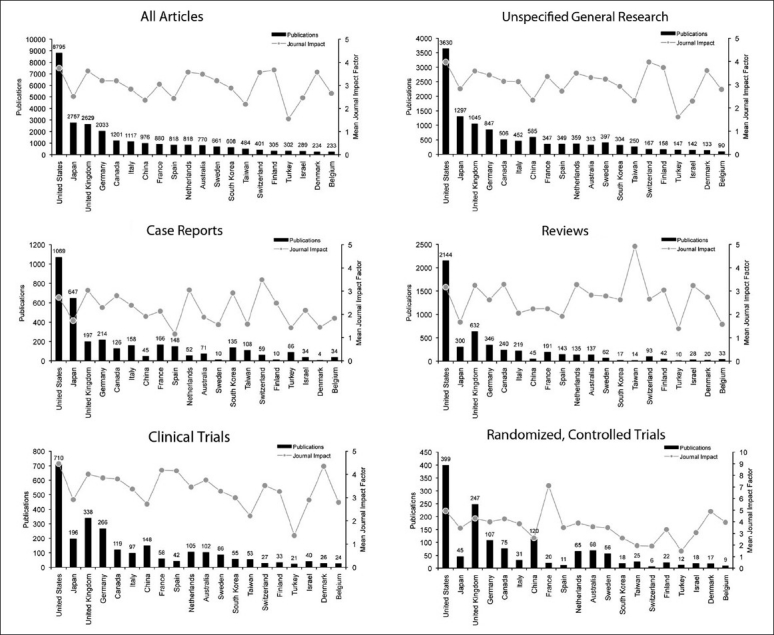
Charts depicting publications and mean journal impact factor for top 20 highest producing countries, by individual article methodology
Table 1.
World, US, and US NIH-funded articles by study type, 1996–2008
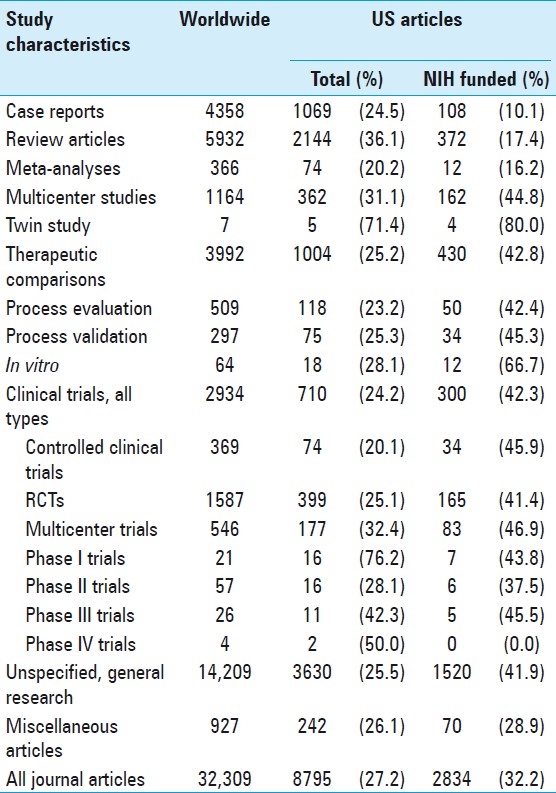
Geographic research growth and relative contribution
Globally, the number of publications grew at a linear rate of 209.93 articles per year (P < 0.001). The United States also displayed a linear growth pattern at 56.2 articles per year (P < 0.001). Of the top five nations, Canada had the highest rate of growth, which followed an exponential model at 11.3% (P < 0.001). China had the largest proportional growth during this period of 1000%. The absolute, relative, and proportional growth rates of top five contributors are detailed in Figure 2.
Figure 2.
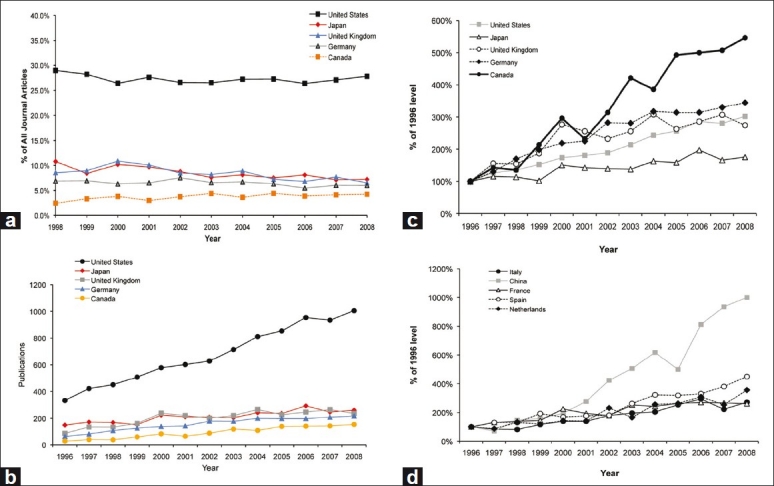
(a) Absolute, (b) relative, and (c and d) proportional growths of articles by country between 1996 and 2008
With regards to relative global contribution, the United States rose from 26.3 to 27.8% between 1996 and 2008. Of the remaining top five contributors, increases were also seen in Germany and Canada, rising from 5.0 to 6.0% and from 2.2 to 4.2%, respectively. Conversely, relative contribution from Japan decreased from 11.7 to 7.2%. The United Kingdom remained relatively unchanged from 6.8 to 6.5%.
Study methodology by geography and growth
Globally, the top three nations in clinical trials were the United States (24.2% of worldwide total), the United Kingdom (11.5%), and Germany (9.1%). However, the top three nations in randomized controlled trials (RCTs) were the United States (25.1%), the United Kingdom (15.6%), and China (7.6%). The leaders in review articles included the United States (36.1%), the United Kingdom (10.7%), and Japan (5.1%). Lastly, the leaders in case reports included the United States (124.5%), Japan (14.8%), and Germany (4.9%) [Figure 1].
National focus varied by country. Within the United States, clinical trials represented 8.1% of articles of which 56.2% were RCTs. Review and case reports represented 24.4 and 12.2% of published articles, respectively. In contrast, review and case reports from Japan represented 10.9 and 23.5%, respectively. Of the clinical trials produced in Japan, 23.0% were RCTs. Higher proportions of clinical trials were seen in the United Kingdom (12.9%) and Germany (13.1%). Lastly, of top 10 nations, China had the greatest relative national focus on clinical trials at 15.1% of which 81.1% represented RCTs.
With respect to growth in productivity according to methodology, review articles and case reports grew linearly at 41.7 and 17.1 articles per year, respectively (both P < 0.001). Clinical trials and RCTs both followed exponential growth patterns, measuring 7.7 and 10.6% per year, respectively (both P < 0.001).
Specialty influence
With regards to specialty contribution, 19,475 (60.3%) first authors were assignable to a specific medical specialty. Leading contributors included neurology (27.7%), internal medicine (6.3%), physical medicine and rehabilitation (PMR) (5.8%), diagnostic radiology (4.4%), and neurological surgery (3.9%). Interestingly, the largest rate of proportional growth was seen in PMR (42–236 articles), which was followed by neurology (362–1009 articles). This was further magnified when examining clinical trials and RCTs in which PMR grew from 4 to 51 articles and from 2 to 35 articles, respectively. This was followed by neurology which grew from 28 to 87 articles in clinical trials and from 16 to 41 articles in RCTs [Figure 3].
Figure 3.
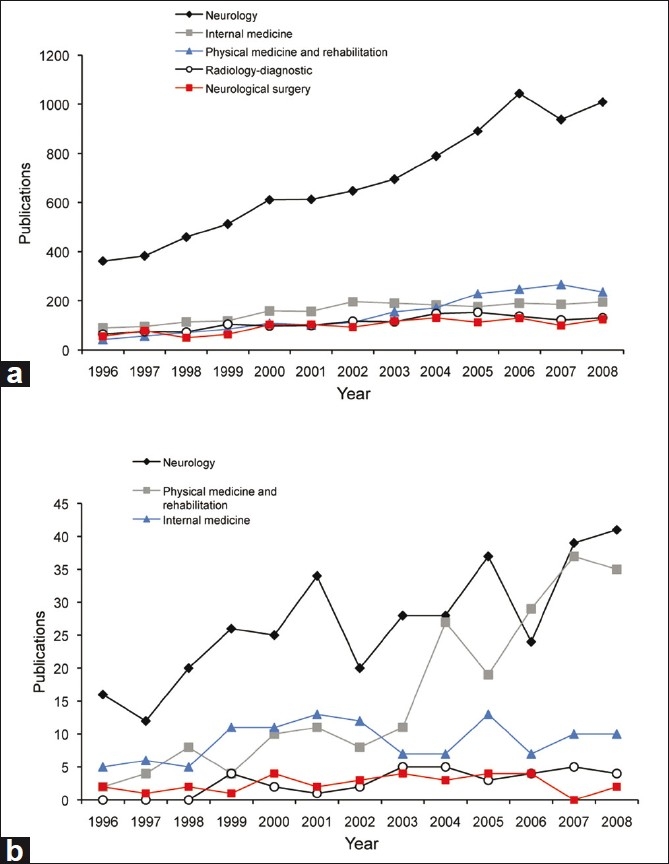
Trends in (a) all publications and (b) randomized controlled trials by specialty, between 1996 and 2008
NIH funding
Of the publications originating from the United States, 2834 (32.2%) received NIH grant support. The fraction of published articles that received NIH support varied by article type. For example, while the NIH supported 300 of 710 (42.3%) clinical trials and 83 of 177 (46.9%) multicenter studies, it only supported 108 of 1069 (10.1%) case reports and 372 of 2144 (17.4%) review articles. The National Institute of Neurological Disorders and Stroke (NINDS) funded 1569 (55.4%) of NIH studies, followed by National Heart, Lung, and Blood Institute (NHLBI) which funded 579 (20.4%) studies. NIH-funded publications grew from 97 to 341 between 1996 and 2008. Non–NIH-funded US publications grew from 236 to 665 between 1996 and 2008. Regarding funding, relative contribution of NIH-funded publications increased from 29.1 to 33.9% between 1996 and 2008 [Figure 4].
Figure 4.
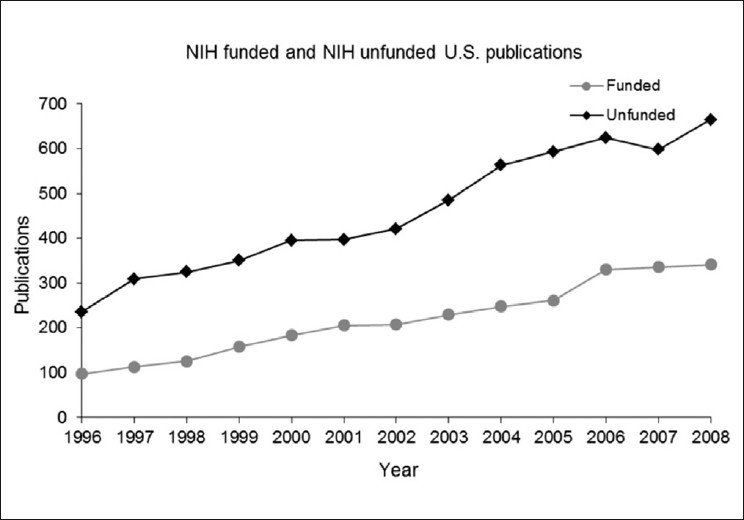
Trends in NIH-funded publications versus unfunded US publications, between 1996 and 2008
Subject analysis
The greatest overall growth rate was displayed by general, uncategorizable stroke research (303 articles/year), though this only represented a rate of increase of ~17% of 1996 productivity levels. The greatest increases compared to 1996 levels, however, were seen in rehabilitation-related papers (33%, 89 articles/year) and epidemiology and public health related papers (41%, 11 articles/year). Lower proportional growth rates were found in medical/surgical therapy related stroke research (25%, 67 articles/year), stroke etiology and prevention research (16%, 50 articles/year), and stroke diagnosis research (14%, 22 articles/year) [Figure 5].
Figure 5.
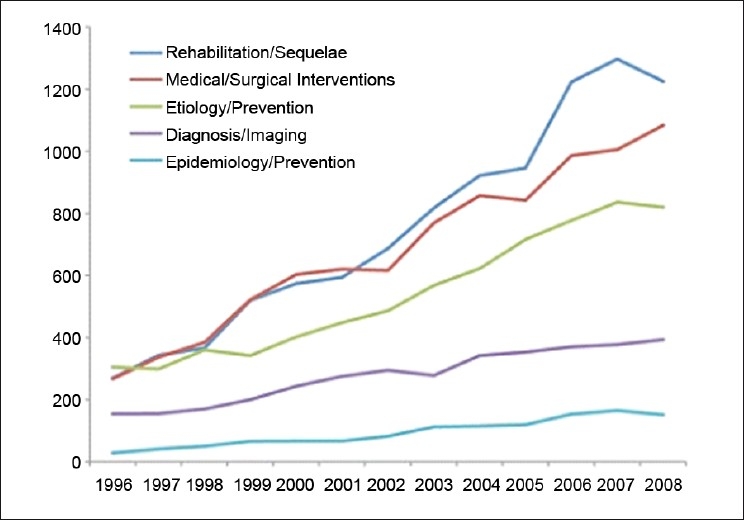
Trend of medical topics, between 1996 and 2008
DISCUSSION
Worldwide productivity
The United States was the leading single nation contributor during the study period, contributing to 27.2% of all articles. However, this figure is considerably lower when comparing United States productivity across multiple disciplines. Specifically, contribution of the United States in science and other medical specialties has reportedly ranged between 40 and 60%.[34,35] These findings imply a greater globalization of stroke-related research. This phenomenon of increasing internationalization has also been well established in science and medicine and has manifested itself by a progressive decline in relative contribution from the United States within surgery, radiology, interventional radiology, and other medical subspecialties.[6,10,12,18,23,35–37,45] Specifically, between 1991 and 2000, relative contribution of the United States to basic science and clinical articles declined from 69.7 to 58.3% and from 60.0 to 52.1%, respectively.[34]
Given this decline, it is remarkable that the United States has maintained its relative global contribution in stroke publications and grown from 26.3 to 27.8% over the last decade. Although this growth and sustained research productivity from the United States is likely multifactorial, one possible reason is the development of novel initiatives in infrastructure to focus stroke research such as the Specialized Programs of Translation Research in Acute Stroke (SPOTRIAS). In 2001, the NINDS issued a grant solicitation for SPOTRIAS which facilitates the “translation of basic research findings into clinical research.”[32] Within 2008, SPOTRIAS related publications accounted for 4.9% (49/1006) of all United States articles, 14.9% (13/87) of clinical trials, and 29.2% (7/24) of multicenter trials.[42] Another possibility may be due to the proportion of neurologists to the population. This ratio is estimated to be 1:26,200 to 1:23,500 in the United States. This reflects a considerably higher neurologist per capita compared to the remaining top five producers which range from 1:41,000 to 1:177,000.[3,4] Thus, a relatively lower number of publications may stem from a smaller workforce and the demands of clinical needs at the expensive of time for research, which has been previously suggested in other literature.[38] An alternative view is that a growth of only 1.5% is too small considering the SPOTRIAS support and ratio of neurologists, and may point to needs of increasing funding and better use of our resources.
When examining the productivity of other countries, we observed that Canada had the highest proportional growth of top five contributing nations and that China had the highest proportional growth of all nations. These data likely reflect several potential etiologies. With respect to Canada, one explanation includes its changing infrastructure in stroke research. In 1999, the Canadian Stroke Network (CSN) was founded and in 2001 the Registry of the Canadian Stroke Network (RCSN) was established.[7] This registry provided investigators with a clinical database to assess outcomes and delivery of care, and established comprehensive stroke centers to increase the efficiency in treating patients with acute ischemic stroke. This registry had collected information from over 50,000 strokes within Canada by 2008, representing a large database for investigators.[8] Regarding China, a large proportional growth of research has also been displayed in other clinical areas.[18] This has been attributed to changing research infrastructure, increasing government funding, and the growing incentives and pressures amongst Chinese authors.[17,39,48] These factors may also be responsible for its robust number of RCTs (7.6% of the world total), despite being the 12th highest national contributor (3.0%). Additionally, given that China has the largest number of stroke deaths in the world, there could also be a greater priority placed on stroke research.[48]
Study methodology
During the study period, the percentage of studies that were clinical trials (9.1%) and RCTs (4.9%) was slightly higher when compared to other topics and specialties, such as interventional oncology, cardiovascular medicine, and neurosurgical research.[5,12,22] Additionally, we observed that RCTs grew at an exponential rate of 10.6% annually. While multifactorial, the previously mentioned infrastructure developments in stroke centres and research, as well as the sustained growth of clinical trials may have played a substantial and positive role in stroke declining to the fourth leading cause of death within the United States.[46]
While these are impressive achievements, nearly a third of literature published worldwide was in the form of case reports and review articles. This emphasis on case reports and review articles has been seen in other specialties.[18] One possibility for this disproportionately low number of clinical trials may stem from the difficulty of enrolling patients in acute stroke trials during an acute stroke setting.[41] Furthermore, the costs of a clinical trial are significantly higher than case series, reports, and review papers. In Canada, the cost of obtaining consent for stroke studies was estimated to be approximately $520,000 US dollars, which accounts for 25% of the RCSN's budget.[47] Additionally, these barriers have led to selection bias by excluding non-native speaking patients.[47] With regards to potential therapeutic drugs in the United States, the federal government allows for waivers of consent in life-threatening emergencies; however, these are seldom used.[21,33,50] Overall, there is still much room to improve the efficiency and dedication to clinical trials. One unanswered question is how these barriers to clinical trials affect the development and testing of interventional devices, all of which are more recently playing a very important role in ischemic stroke treatment.
Specialty influence
Over the last decade, mortality from stroke has decreased. Despite this, stroke has remained the leading cause of disability, resulting in a greater demand for stroke rehabilitation research.[20,49] This need has reflected itself with a rise in RCTs within stroke rehabilitation.[43] This was also evident in our analysis. Specifically, despite neurology department's dominance in the number of stroke-related publications, PMR had the largest proportional growth of overall publications and RCTs. This growth will likely continue and hopefully limit the impact of stroke-related disability.
Influence of funding
Examining the US articles specifically, 32.2% of published articles received NIH funding, with a high proportion of those being clinical trials including RCTs and multicenter trials, which is unsurprising given the high cost associated with running clinical trials.[24] Additionally, the relative contribution of NIH-funded publications increased nearly 5% during the study period. However, stroke research remains underfunded when examining its burden on mortality and disability.[15,16,19] In the mid-1990s, the Institute of Medicine set a goal that disease-specific research funding should be comparable to burden of disease on society.[15,16] In 2006, stroke research was underfunded by approximately 20% less than expected on this basis.[50] Although this study did not examine funding patterns outside the US, a lack of funding in stroke research relative to other disease processes has been observed in Europe as well.[30,31] These findings are alarming given that the importance of funding and its positive association with research productivity has been previously established.[22]
Limitations
When interpreting the results of this study, several limitations should be kept in mind. First, this study is limited to only articles indexed within MEDLINE, which does not encompass all types of research. Nonetheless, MEDLINE is a comprehensive resource that includes 17.4 million articles from over 5200 journals in 37 languages.[25,26] There is also a possible bias within MEDLINE toward English language and Western journals. Lastly, using the first author's affiliation can be potentially problematic in instances where authors from different institutions or clinical departments co-author a paper. Using only the first author's affiliation may underweigh the contribution of other authors if they tend to systematically be non-first authors. On the other hand, giving non-first authors equal credit may overweigh the contribution of certain specialties, such as statisticians. Evidence has shown that first authors account for a preponderance of work and are most deserving of credit.[11,40] Weighing these factors, it was decided that using the first author's affiliation was the best compromise.
CONCLUSION
In conclusion, there is an unprecedented sustained growth in productivity for stroke research in the United States. Research within stroke has also seen a steady increase in the number of clinical trials, especially by pain management and rehabilitation.
Footnotes
Available FREE in open access from: http://www.surgicalneurologyint.com/text.asp?2012/3/1/27/92941
Contributor Information
Daniel S. Chow, Email: dsc9004@nyp.org.
Jason S. Hauptman, Email: jhauptman@mednet.ucla.edu.
Tony T. Wong, Email: ttw9002@nyp.org.
Nestor R. Gonzalez, Email: ngonzalez@mednet.ucla.edu.
Neil A. Martin, Email: neilmartin@mednet.ucla.edu.
Angella A. Lignelli, Email: al270@mail.cumc.columbia.edu.
Michael W. Itagaki, Email: mitagaki@gmail.com.
REFERENCES
- 1.Akaike H. A new look at the statistical model identification. IEEE Trans Automat Contr. 1974;19:716–23. [Google Scholar]
- 2.Asplund K. Clinimetrics in stroke research. Stroke. 1987;18:528–30. doi: 10.1161/01.str.18.2.528. [DOI] [PubMed] [Google Scholar]
- 3.Beccker WJ. Neurologists and the numbers. Can J Neurol Sci. 2005;32:399–400. [PubMed] [Google Scholar]
- 4.Bergen DC. World Federation of Neurology Task Force on Neurological Services. Training and distribution of neurologists worldwide. J Neurol Sci. 2002;198:3–7. doi: 10.1016/s0022-510x(02)00071-0. [DOI] [PubMed] [Google Scholar]
- 5.Burnett MG, Stein SC, Grady MS. What we research: Survey of American Association of Neurological Surgeons and Congress of Neurological Surgeons member publications. J Neurosurg. 2004;100:73–8. doi: 10.3171/jns.2004.100.1.0073. [DOI] [PubMed] [Google Scholar]
- 6.Cappell MS, Davis M. A significant decline in the American domination of research in gastroenterology with increasing globalization from 1980 to 2005: An analysis of American authorship among 8,251 articles. Am J Gastroenterol. 2008;103:1065–74. doi: 10.1111/j.1572-0241.2007.01767.x. [DOI] [PubMed] [Google Scholar]
- 7.Canadian Stroke Network. About Us. [Last cited 2011 Aug 25]. Available from: https://www.rcsn.org/AboutUs/AboutUs.aspx .
- 8.Canadian Stroke Network. Newsletters. [Last cited 2011 Aug 25]. Available from: http://www.canadianstrokenetwork.ca/index.php/news/newsletters-2/
- 9.Chang AA, Heskett KM, Davidson TM. Searching the literature using medical subject headings versus text word with PubMed. Laryngoscope. 2006;116:336–40. doi: 10.1097/01.mlg.0000195371.72887.a2. [DOI] [PubMed] [Google Scholar]
- 10.Chen MY, Jenkins CB, Elster AD. Internationalization of the American Journal of Roentgenology: 1980-2002. AJR Am J Roentgenol. 2003;181:907–12. doi: 10.2214/ajr.181.4.1810907. [DOI] [PubMed] [Google Scholar]
- 11.Chew FS. The scientific literature in diagnostic radiology for American readers: A survey and analysis of journals, papers, and authors. AJR Am J Roentgenol. 1986;147:1045–55. doi: 10.2214/ajr.147.5.1055. [DOI] [PubMed] [Google Scholar]
- 12.Chow DS, Itagaki MW. Interventional oncology research in the United States: Slowing growth, limited focus, and a low level of funding. Radiology. 2010;257:410–7. doi: 10.1148/radiol.10100070. [DOI] [PubMed] [Google Scholar]
- 13.Chuang KY, Huang YL, Ho YS. A bibliometric and citation analysis of stroke-related research in Taiwan. Scientometrics. 2007;72:201–12. [Google Scholar]
- 14.Dirnagl U. Bench to bedside: the quest for quality in experimental stroke research. J Cereb Blood Flow Metab. 2006;26:1465–78. doi: 10.1038/sj.jcbfm.9600298. [DOI] [PubMed] [Google Scholar]
- 15.Gillum LA, Gouveia C, Dorsey ER, Pletcher M, Mathers CD, McCulloch CE, et al. NIH disease funding levels and burden of disease. PLoS One. 2011;6:e16837. doi: 10.1371/journal.pone.0016837. [DOI] [PMC free article] [PubMed] [Google Scholar]
- 16.Gross CP, Anderson GF, Powe NR. The relation between funding by the National Institutes of Health and the burden of disease. N Engl J Med. 1999;340:1881–7. doi: 10.1056/NEJM199906173402406. [DOI] [PubMed] [Google Scholar]
- 17.Hather GJ, Haynes W, Higdon R, Kolker N, Stewart EA, Arzberger P, et al. The United States of America and scientific research. PLoS One. 2010;5:e12203. doi: 10.1371/journal.pone.0012203. [DOI] [PMC free article] [PubMed] [Google Scholar]
- 18.Hauptman JS, Chow DS, Martin NA, Itagaki MW. Research productivity in neurosurgery: Trends in globalization, scientific focus, and funding. J Neurosurg. 2011;115:1262–72. doi: 10.3171/2011.8.JNS11857. [DOI] [PubMed] [Google Scholar]
- 19.Johnston SC. The 2008 William M. Feinberg lecture: Prioritizing stroke research. Stroke. 2008;39:3431–6. doi: 10.1161/STROKEAHA.108.525584. [DOI] [PubMed] [Google Scholar]
- 20.Kunst AE, Amiri M, Janssen F. The decline in stroke mortality: Exploration of future trends in 7 Western European countries. Stroke. 2011;42:2126–30. doi: 10.1161/STROKEAHA.110.599712. [DOI] [PubMed] [Google Scholar]
- 21.Luce JM. Informed consent for clinical research involving patients with chest disease in the United States. Chest. 2009;135:1061–8. doi: 10.1378/chest.08-2621. [DOI] [PubMed] [Google Scholar]
- 22.Lyubarova R, Itagaki BK, Itagaki MW. The impact of National Institutes of Health funding on U.S. cardiovascular disease research. PLoS One. 2009;4:e6425. doi: 10.1371/journal.pone.0006425. [DOI] [PMC free article] [PubMed] [Google Scholar]
- 23.Mervis J. Scientific publishing. U.S. output flattens, and NSF wonders why. Science. 2007;317:582. doi: 10.1126/science.317.5838.582. [DOI] [PubMed] [Google Scholar]
- 24.Mitka M. Strategies sought for reducing cost, improving efficiency of clinical research. JAMA. 2011;306:364–5. doi: 10.1001/jama.2011.1018. [DOI] [PubMed] [Google Scholar]
- 25.National Library of Medicine. Bibliometric Services Division: Data, News and Update Information. National Library of Medicine website. [Last cited 2009 Jun 27]. Available from: http://www.nlm.nih.gov/bsd/revup/revup_pub.html#med_update .
- 26.National Library of Medicine. Fact Sheet: MEDLINE. National Library of Medicine website. [Last cited 2009 Jun 27]. Available from: http://www.nlm.nih.gov/pubs/factsheets/medline.html .
- 27.National Library of Medicine. Fact sheet: Online indexing. [Last cited 2011 Jun 4]. Available from: http://www.nlm.nih.gov/pubs/factsheets/online_indexing_system.html .
- 28.National Library of Medicine. Introduction to MeSH-2011. [Last cited 2011 Jun 4]. Available from: http://www.nlm.nih.gov/mesh/introduction.html .
- 29.National Library of Medicine. Publication Characteristics (Publication Types) – Scope Notes. [Last cited 2009 Jun 27]. Available from: http://www.nlm.nih.gov/mesh/pubtypes2008.html .
- 30.Pendlebury ST, Rothwell PM, Algra A, Ariesen MJ, Bakac G, Czlonkowska A, et al. Underfunding of stroke research: A Europe-wide problem. Stroke. 2004;35:2368–71. doi: 10.1161/01.STR.0000140632.83868.a2. [DOI] [PubMed] [Google Scholar]
- 31.Pendlebury ST. Worldwide under-funding of stroke research. Int J Stroke. 2007;2:80–4. doi: 10.1111/j.1747-4949.2007.00126.x. [DOI] [PubMed] [Google Scholar]
- 32.Penn AS. 2002 Stroke Testimony: National Institute of Neurological Disorders and Stroke (NINDS) [Last cited 2011 Aug 25]. Available from: http://www.ninds.nih.gov/news_and_events/congressional_testimony/2002_stroke_testimony.htm .
- 33.Protection of human subjects; informed consent and waver of informed consent requirements in certain emergency research. U.S. Food and Drug Administration. [Last cited 2011 Aug 25]. Available from: http://www.fda.gov/ScienceResearch/SpecialTopics/RunningClinicalTrials/ucm118995.htm .
- 34.Rahman M, Fukui T. A decline in the U.S. share of research articles. N Engl J Med. 2002;347:1211–2. doi: 10.1056/NEJM200210103471523. [DOI] [PubMed] [Google Scholar]
- 35.Rahman M, Fukui T. Geography of randomized controlled trials in general internal medicine: Is the United States’ share declining? Am J Med. 2003;114:510–1. doi: 10.1016/s0002-9343(03)00062-7. [DOI] [PubMed] [Google Scholar]
- 36.Rahman M, Haque TL, Fukui T. Research articles published in clinical radiology journals: Trend of contribution from different countries. Acad Radiol. 2005;12:825–9. doi: 10.1016/j.acra.2005.03.061. [DOI] [PubMed] [Google Scholar]
- 37.Ray CE, Jr, Gupta R, Blackwell J. Changes in the American interventional radiology literature: Comparison over a 10-year time period. Cardiovasc Intervent Radiol. 2006;29:599–604. doi: 10.1007/s00270-005-0209-7. [DOI] [PubMed] [Google Scholar]
- 38.Sanossian N, Ohanian AG, Saver JL, Kim LI, Ovbiagele B. Frequency and determinants of nonpublication of research in the stroke literature. Stroke. 2006;37:2588–92. doi: 10.1161/01.STR.0000240509.05587.a2. [DOI] [PubMed] [Google Scholar]
- 39.Shao J, Shen H. The outflow of academic papers from China: Why is it happening and can it be stemmed? Learn Publ. 2011;24:95–7. [Google Scholar]
- 40.Slone RM. Coauthors contributions to major papers published in the AJR: Frequency of undeserved coauthorship. AJR Am J Roentgenol. 1996;167:571–9. doi: 10.2214/ajr.167.3.8751654. [DOI] [PubMed] [Google Scholar]
- 41.Slyter H. Ethical challenges in stroke research. Stroke. 1998;2:1725–9. doi: 10.1161/01.str.29.8.1725. [DOI] [PubMed] [Google Scholar]
- 42.SPOTRIAS Stroke Network. Publications. [Last cited 2011 Aug 25]. Available from: http://www.spotrias.org/research/publications/
- 43.Teasell R. Stroke recovery and rehabilitation. Stroke. 2003;34:365–6. doi: 10.1161/01.str.0000054630.33395.e2. [DOI] [PubMed] [Google Scholar]
- 44.Thompson Scientific. Journal Citation Reports. [Last cited 2008 Oct 11]. Available from: http://scientific.thomson.com/products/jcr/
- 45.Tompkins RK, Ko CY, Donovan AJ. Internationalization of general surgical journals: Origin and content of articles published in North America and Great Britain from 1983 to 1998. Arch Surg. 2001;136:1345–51. doi: 10.1001/archsurg.136.12.1345. [DOI] [PubMed] [Google Scholar]
- 46.Towfighi A, Saver JL. Stroke declines from third to fourth leading cause of death in the United States: Historical perspective and challenges ahead. Stroke. 2011;42:2351–5. doi: 10.1161/STROKEAHA.111.621904. [DOI] [PubMed] [Google Scholar]
- 47.Tu JV, Willison DJ, Silver FL, Fang J, Richards JA, Laupacis A, et al. Investigators in the Registry of the Canadian Stroke Network. Impracticability of informed consent in the Registry of the Canadian Stroke Network. N Engl J Med. 2004;350:1414–21. doi: 10.1056/NEJMsa031697. [DOI] [PubMed] [Google Scholar]
- 48.Wei G, Ji X, Bai H, Ding Y. Stroke research in China. Neurol Res. 2006;28:11–5. doi: 10.1179/016164106X91807. [DOI] [PubMed] [Google Scholar]
- 49.Whitall J. Stroke rehabilitation research: Time to answer more specific questions? Neurorehabil Neural Repair. 2004;18:3–8. doi: 10.1177/0888439003262876. [DOI] [PubMed] [Google Scholar]
- 50.Wichman A, Sandler AL. Research involving critically ill subjects in emergency circumstances: New regulations, new challenges. Neurology. 1997;48:1151–5. doi: 10.1212/wnl.48.5.1151. [DOI] [PubMed] [Google Scholar]


